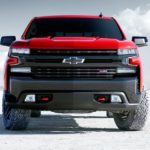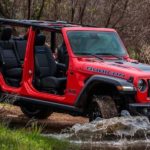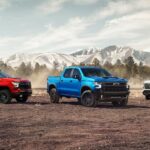When it comes to off-road vehicles, certain names have become legends: Jeep Wrangler, Land Rover, Ford Bronco, and Toyota’s TRD models. Up until about 45 years ago, there was another name often spoken alongside Jeep, which was the Harvester Scout. The Scout was first introduced in 1960, and for two decades, it offered impressive performance out on the trail, creating an alternative for off-road enthusiasts looking for something other than a Jeep. Sadly, its run ended and we were left without this bold and stylish choice. Fortunately, other brands and models have risen to take its place, but we’ve still been left with a Scout-shaped hole in our automotive hearts.
That is, until now. No longer being developed under the International Harvester name, the Scout is set to make an exciting return as a powerful new electric vehicle (EV) designed to tear up the trail. Perhaps most remarkably, it will be developed under the Volkswagen umbrella because VW acquired the Scout name and trademark several years ago. Recently-announced Scout Motors has been ramping up design and building a new factory in South Carolina to begin development and manufacturing of this all-new, all-electric Scout. Let’s take a look at the history of this once-iconic model name and what we know so far about its return so you can see why so many people are excited about the resurrection of the Scout.
Origins of the International Harvester Scout
First released in 1960, the origins of the Scout go back to that of the company that built it, International Harvester. They were a manufacturer here in the US that largely specialized in agricultural equipment and construction vehicles. International Harvester Company was founded in 1902, which tells you how far back they go. They primarily built tractors, as well as cultivators, combines, dump trucks, blade and bucket attachments, and much more. They had been building light-duty trucks since the early 1900s, but in 1960, International Harvester decided to make something different.
Inspired by the design and success of the original Jeep CJ (the first civilian Jeep), International Harvester began working on something that could compete with it. They saw the potential for rugged and dependable recreational vehicles designed to go just about anywhere. Their experience in agricultural equipment meant they knew how to approach designing something that could handle the roughest and least predictable terrain. All they had to do was repurpose that understanding in the direction of a consumer vehicle meant to help people enjoy the weekend, which is exactly what they did.
The design and functionality of the Jeep were a major influence on their approach to the original Scout since that was the only vehicle with a similar purpose at the time. This was shortly after World War II and all of the effort that had gone into developing the Jeep for the war and creating a civilian version afterward. One of the earliest designs for the Scout apparently happened in the chief designer’s kitchen one night, which stirred interest in others at International Harvester. All told it only took about 24 months for the original Scout to be developed, modeled, approved, and moved into production, marking an incredibly quick process for the auto industry.
Harvester Scout Models and Changes
This quick design process resulted in the first model, known as the Scout 80, which was essentially a light-duty truck. Early versions were sold with removable sliding side windows and a fold-down windshield (sound familiar, Jeep Wrangler fans?) It was also powered by an I-4 engine. The Scout 80 was offered from 1960 through 1965, followed by an upgraded Scout 800 model from 1966 to 1971. The Scout 800 featured bucket seats for more comfort, improved instrumentation, and other enhancements like electric wipers and more powerful engines.
In 1971, International Harvester released a redesigned Scout II, which replaced the Scout 800 as essentially a second-generation version of this vehicle. This model was available with a soft top, a fully metal Traveltop, or a Roadster top that created a half cab for a stylish touch. In 1977, they released the Super Scout II, designed to directly compete with the Jeep CJ and provide drivers with a fantastic off-road vehicle. It featured removable fabric doors, roll bars, and a soft top, so it could be open to nature while drivers were on the trail. The Super Scout II even had windshield-mounted side mirrors to maintain visibility when the doors were removed, something some companies still struggle with today. Changes to the auto industry throughout the 1970s spelled the end for the Scout, and it was discontinued in 1980.
Modern Off-Road Models
Since then, off-road vehicles have continued to be a niche market, but there’s no denying that it’s a niche that’s been growing. The Jeep Wrangler survived the tumultuous changes throughout the 1980s and ‘90s. In recent years, it continues to be one of the first vehicles people think of when asked about a trail-ready SUV. It’s been joined by heavy hitters like the Ford Bronco, Bronco Sport, and Toyota 4Runner, off-road trucks like the Chevy ZR2 models, Ford Tremor trims, and more. We’ve even had high-performance off-road trucks like the Ram TRX and Ford Raptor, creating incredible vehicles surpassing anything I ever expected for the off-road segment. And yet, it seems there’s room for one more.
Return of the Scout
A few years ago, Volkswagen acquired the Scout trademark as part of a larger deal, and people started wondering if they would utilize it. After many rumors and speculations, we know that Scout is making a comeback, not simply as a VW model but as its own brand within the larger VW family of vehicles. Scout Motors has been launched with offices in South Carolina as they’re ready to take the auto industry by storm by building a massive production facility (also in South Carolina) designed to produce up to 200,000 vehicles per year.
So far, we don’t know much about the all-new Scout that’s coming, but a few details have been released to give us a general sense of what to expect. First and foremost, this will be an all-electric model with a clear off-road SUV design, which we should expect to have inspirational touches from the original Scout models of the past. I imagine they’ll be taking aim squarely at both the Wrangler and the Ford Bronco, though it’ll be interesting to see if they choose a smaller compact design or go all-in with a midsize model. They could also offer both, like Ford does. At the moment, this is all we know. They have promised a big reveal later this summer, but beyond showing off a tease of its front silhouette, their lips are sealed for now.
Will the Scout Be Your Next Off-Road Machine?
Although we’re getting some kind of reveal later this year, don’t expect to start seeing the Scout hit the trail until 2026. It could happen late next year, but that would shock everyone. Given how the auto industry seems to move these days, a wide release of the Scout could even slide to 2027, but we’ll have to see what happens. That being said, if you’re interested in an off-road SUV, particularly if the idea of one that creates zero emissions and lets you leave the gas pump behind captures your imagination, then the Scout should be squarely on your radar. If you’re looking for an SUV to take onto the trail right now, the Wrangler or Bronco is your best bet, but that’s likely to change in a few years. I, for one, can’t wait, and I’m eagerly looking forward to the big Scout reveal in the next few months.




